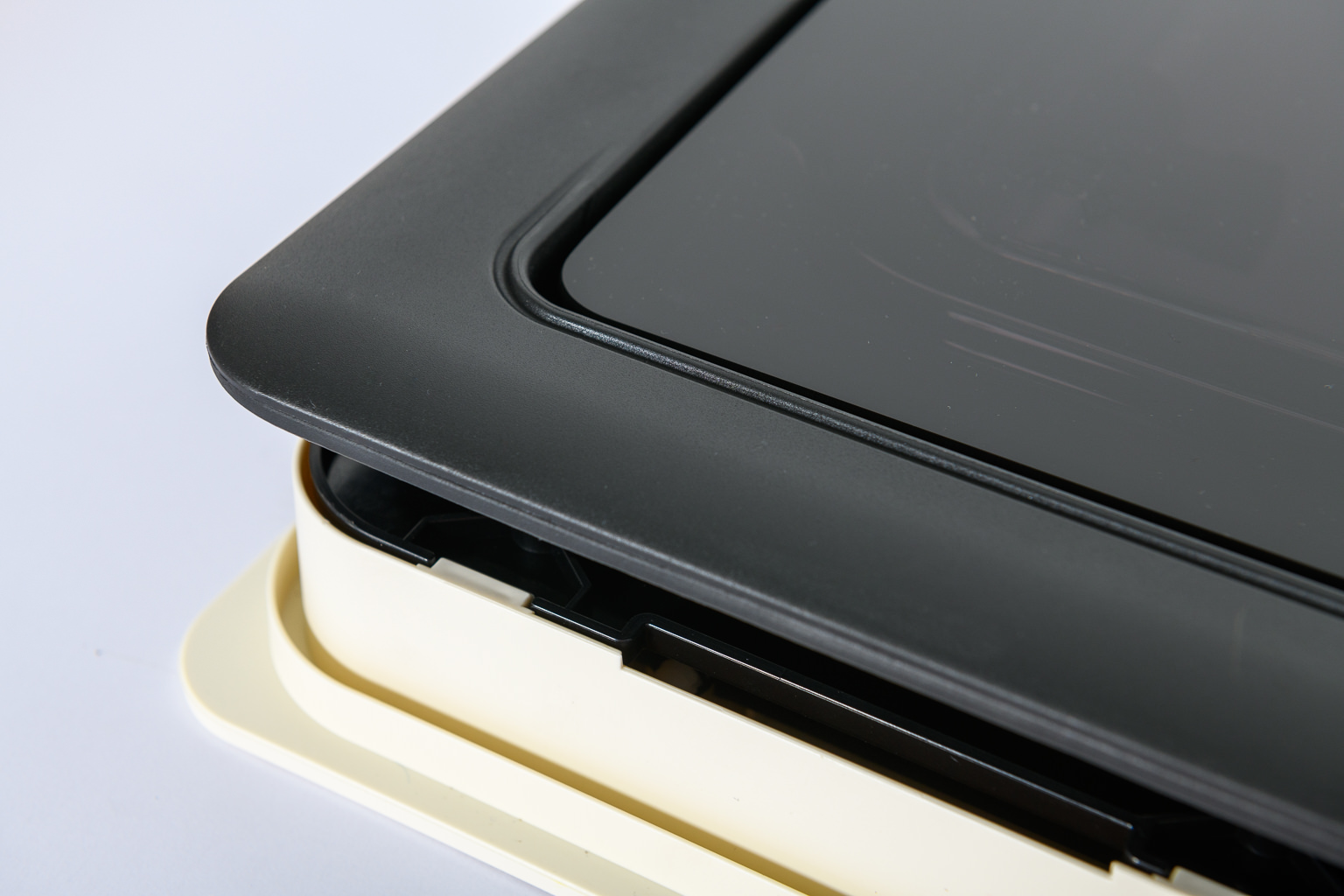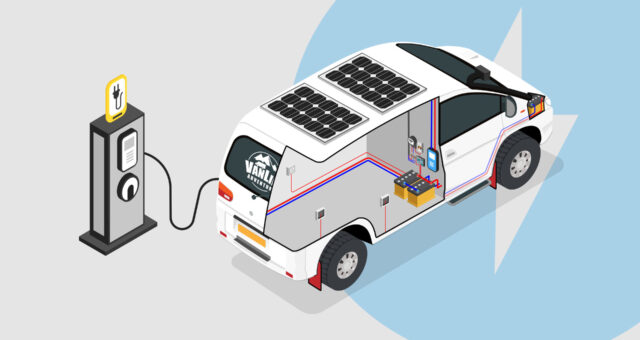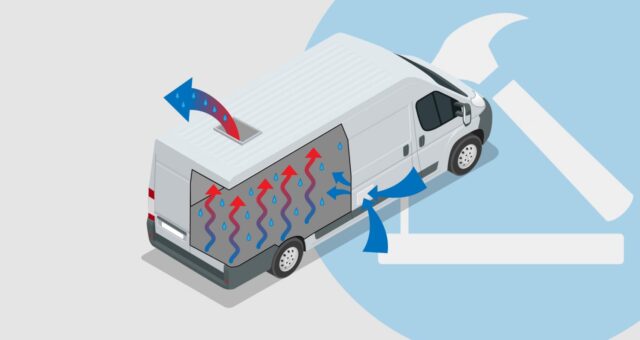- Arron
- Updated: 28th September 2020
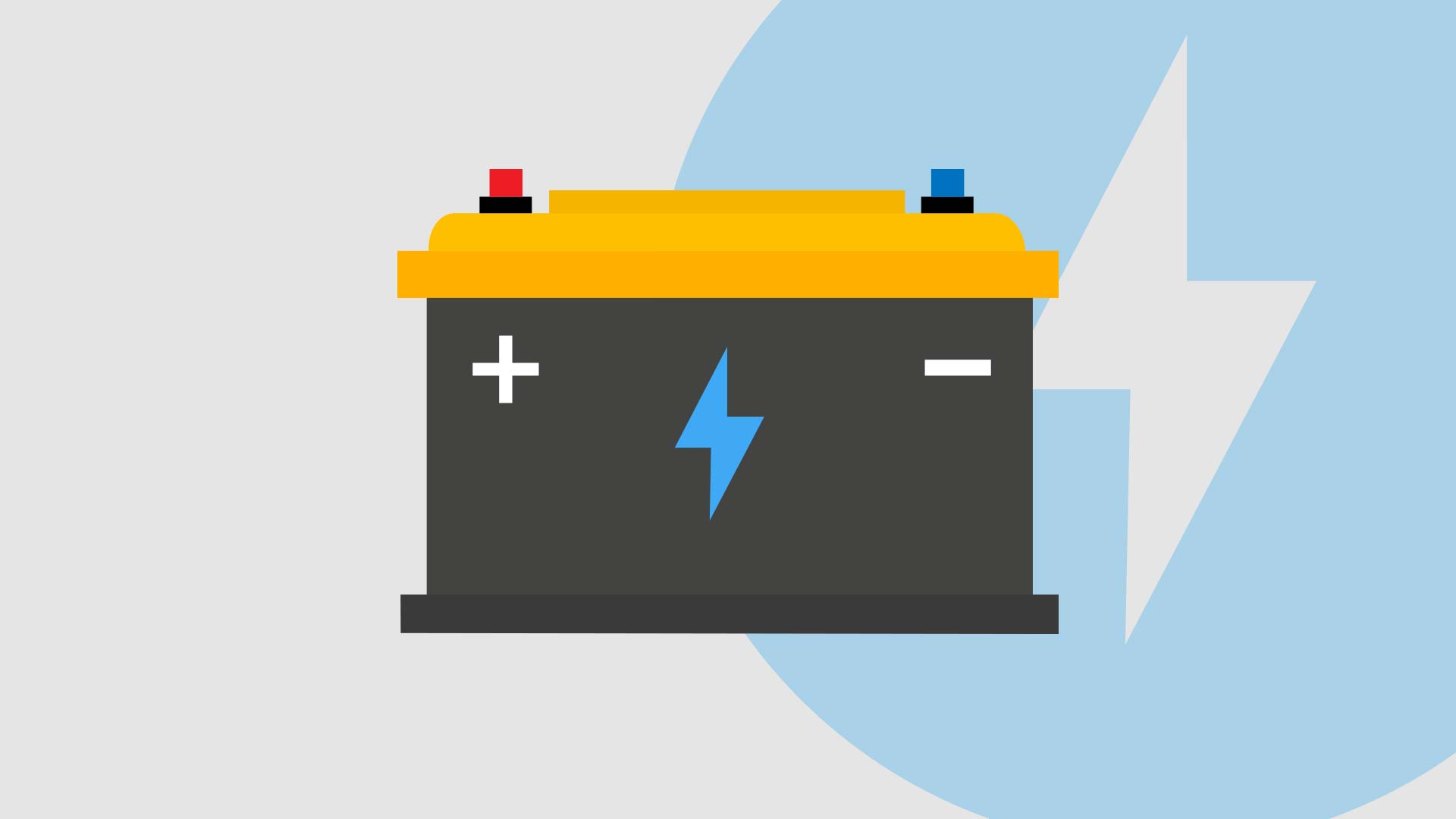
[su_divider top=”no” divider_color=”#e2e2e2″ size=”1″ margin=”30″]
Whether you plan on spending your time on campsites with full electric hook-up, or maybe you plan on going completely off-grid, having a leisure battery installed aboard your campervan is essential. This page explains everything you need to know when it comes to a leisure battery.
All 12-volt equipment aboard your campervan will ultimately rely on a leisure battery.
However, it is worth noting that batteries designed to start a vehicle are made differently to the ones specifically intended to run the appliances aboard a campervan.
Although both batteries do supply 12-volt electric power, it’s the way they do it that makes them different.
[su_divider top=”no” divider_color=”#e2e2e2″ size=”1″ margin=”60″]
What makes a leisure battery different from a car battery?
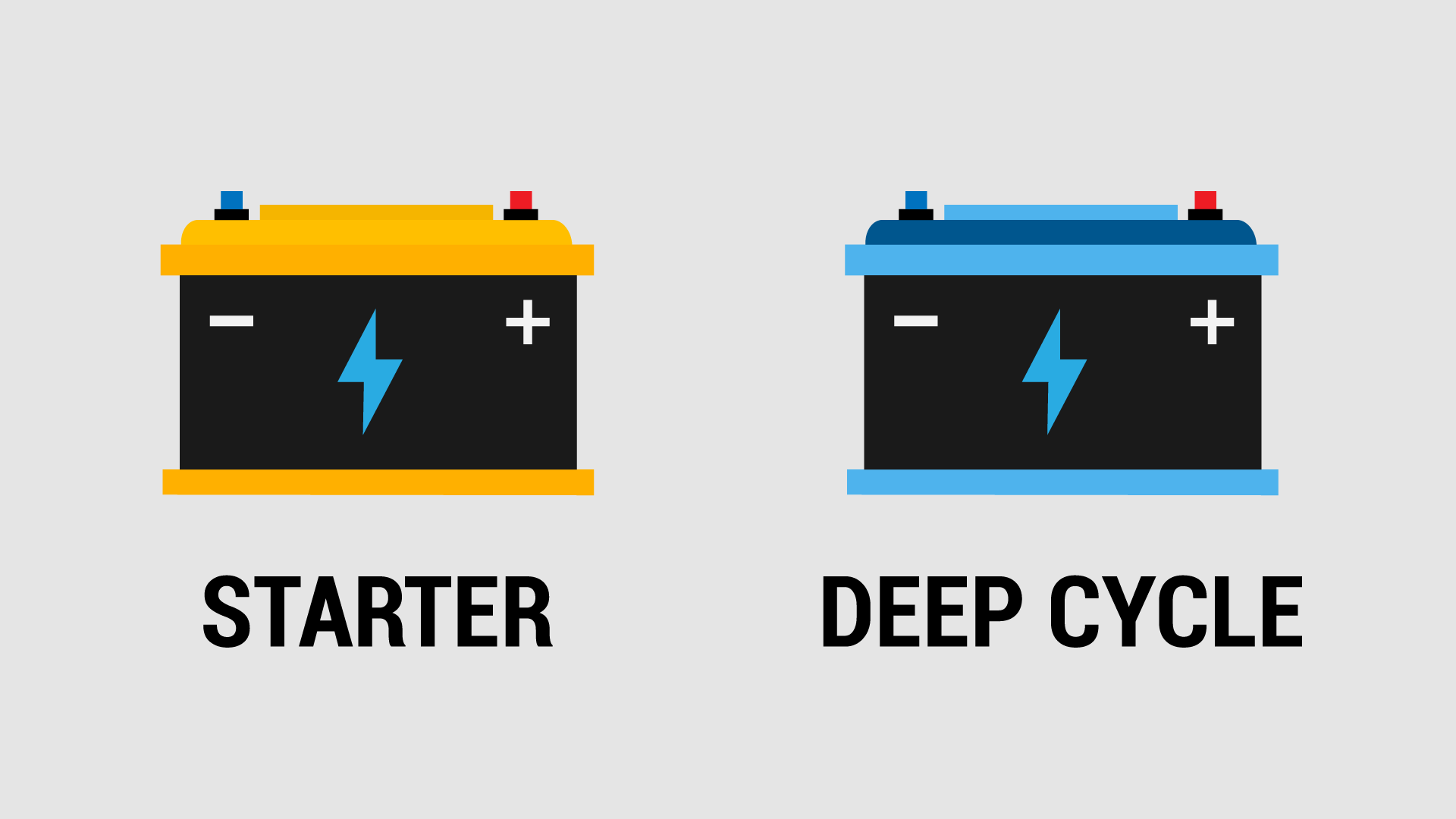
[su_note note_color=”#fafafa” text_color=”#000000″ radius=”0″]
Starter Battery (Crank)
A standard car battery, otherwise known as a crank battery, is generally designed to provide a high burst of power for a short period. A crank battery needs to be able to provide enough power to rotate the vehicle’s engine to around 1200 rpm. The battery also needs to perform well in ambient temperatures as low as -30°C. It’s not uncommon for an engine to require 1000 amps of power just to get it going. Depending on the battery technology, If you were to take a look inside a crank battery, you would find lots of plates (these are the electrodes). Each plate gives a large surface area that allows the release of fast, high cranking currents. The more plates installed inside a crank battery, the thinner they become.
[/su_note]
[su_note note_color=”#fafafa” text_color=”#000000″ radius=”0″]
Leisure Battery (Deep Cycle)
A leisure battery, otherwise known as a deep-cycle battery has to provide a steady flow of current over a prolonged period. Compared to a crank battery, the plates inside a deep-cycle battery do not require a high total surface area. In contrast, the plates need to be much thicker. As a result, a deep cycle battery can efficiently discharge a low, stable current over a long period. A deep cycle battery is also designed to allow hundreds of deep discharges (deep-cycles) throughout the batteries lifespan. Certain deep-cycle battery types have a depth-of-discharge (D.O.D.) rate as much as 80% before having to re-charge.[1]
[/su_note]
[su_divider top=”no” divider_color=”#e2e2e2″ size=”1″ margin=”60″]
Battery Technologies
When it comes to selecting what type of leisure battery to use aboard your campervan, you must first learn about the different battery technologies available.
Those are:
- Vented Lead Acid Battery (V.L.A.)
- Valve-Regulated Lead-Acid Battery (V.R.L.A/S.L.A)
- Lithium Battery (Li-ion)
[su_divider top=”no” divider_color=”#e2e2e2″ size=”1″ margin=”60″]
BATTERY TECHNOLOGY 1: V.L.A. Batteries
What is a V.L.A. battery?
The abbreviation V.L.A. stands for ‘vented lead-acid’. A V.L.A battery is a type of lead-acid battery used to store and supply power. These types of batteries are the most common type found in a campervan.
The battery itself is non-sealed, which allows both hydrogen and oxygen (a by-product produced from charging) to vent freely into the atmosphere.
[su_spacer size=”20″]
Why are V.L.A. batteries called flooded or wet batteries?
V.L.A. batteries are constructed with a lead or lead alloy substrates. They are then submerged in a reactive electrolyte solution.
As the electrolyte solution remains in a liquid state, these batteries have become known as flooded or wet batteries.
[su_spacer size=”20″]
What are the main types of V.L.A. batteries available?
The primary V.L.A. leisure battery available is called an open lead-acid battery.
[su_spacer size=”20″]
Open [Vented] Lead-Acid Battery

[su_divider top=”no” divider_color=”#e2e2e2″ size=”1″ margin=”30″]
[su_row][su_column size=”1/2″ center=”no” class=””]
REASONS TO BUY
[su_list icon=”icon: check-circle” icon_color=”#000000″ class=”page-list”]
- Excellent variety in battery size (both physical dimension and capacities)
- Lowest-cost out of all battery technologies
- Tried-and-true technology
- Simple operation
[/su_list]
[/su_column]
[su_column size=”1/2″ center=”no” class=””]
REASONS TO AVOID
[su_list icon=”icon: times-circle” icon_color=”#000000″]
- Requires ventilation
- Requires regular attention & maintenance
- Relatively low cycle life
- Heavy compared to alternate battery technologies
- Permanent damage if depth-of-discharge goes beyond 50%
- Long-term storage in a discharged condition can lead to irreversible sulfation (polarisation of electrodes)
[/su_list]
[/su_column][/su_row]
[su_divider top=”no” divider_color=”#e2e2e2″ size=”1″ margin=”30″]
[su_spacer size=”20″]
What is an open lead-acid battery?
Invented back in 1859 by French physician Gaston Planté, lead-acid batteries were the first battery available for commercial use. [2]
In the simplest terms, lead plates sit in a liquid solution of sulphuric acid. For that reason, these batteries are often referred to as flooded batteries.
Even today, these batteries continue to be in extensive use, and for a good reason. Lead-acid batteries are dependable and are one of the cheapest ways to store power when it comes to cost-per-watt.
[su_spacer size=”20″]
What is the recommended depth of discharge for an open lead-acid battery?
An open lead-acid battery should never drop below 50% of its charge level capacity. Going beyond these levels can cause irreparable damage to the battery and dramatically reduce its lifespan. [3]
[su_spacer size=”20″]
How many cycles can I expect from an open lead-acid leisure battery?
The number of charge cycles a gel battery will produce is directly dependant on the depth of discharge and battery manufacture/model.
Furthermore, these figures will vary widely based on:
- The environment of the battery
- How the battery is used
- How the battery is charged
- The age of the unit
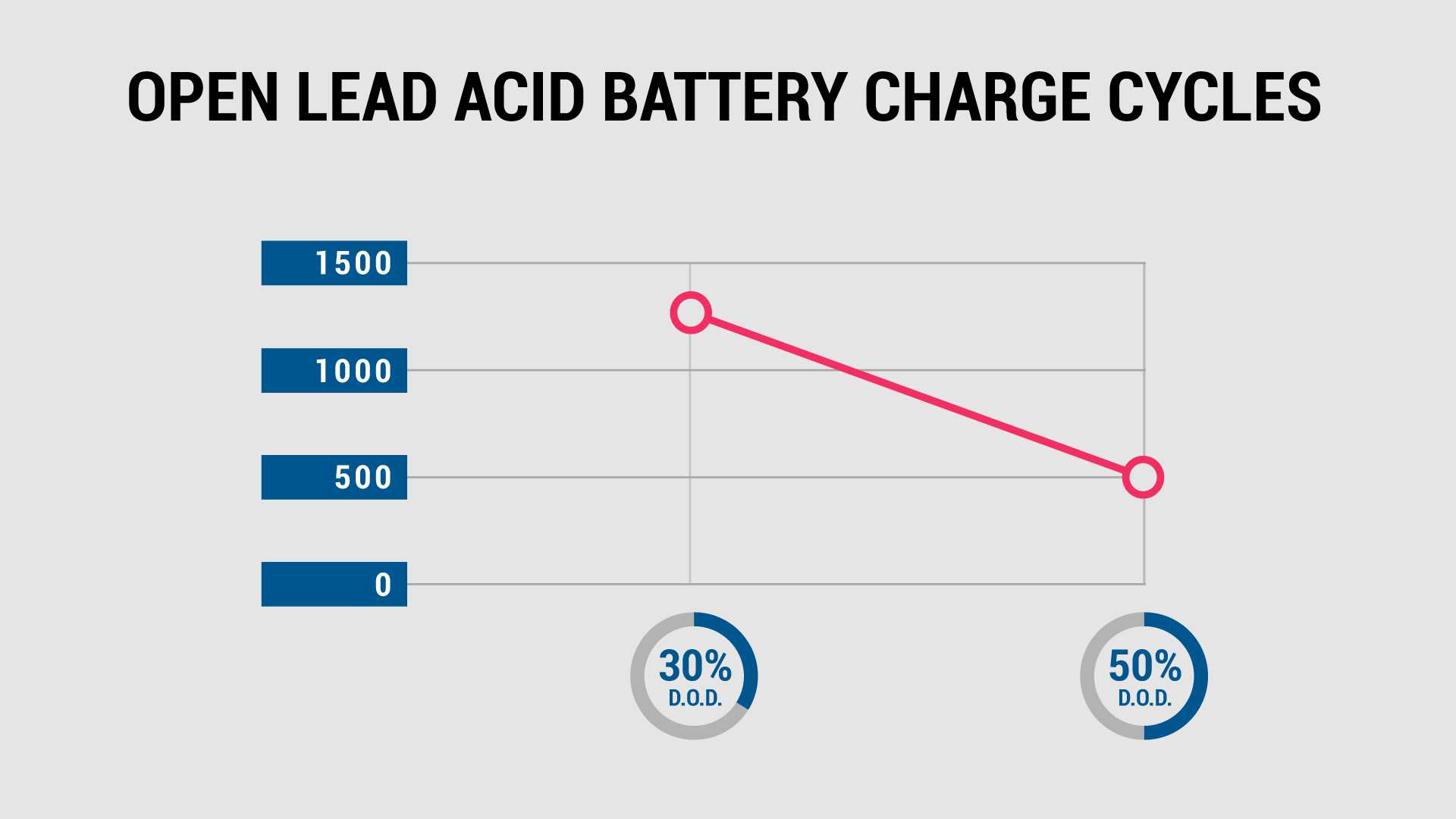
[su_note note_color=”#bedced” text_color=”#000000″ radius=”0″]
Cycles Vs. D.O.D
- 500 cycles @ 50% depth of discharge
- 1300 cycles @ 30% depth of discharge
Source: The figures listed here are taken directly from a scientific study published by Pveducation.
[/su_note]
[su_spacer size=”20″]
Do I have to vent an open lead-acid battery?
An open lead-acid battery should be installed in a well-ventilated area.
During charging (especially overcharging), due to a chemical reaction, both oxygen and hydrogen gas are produced. This can often create a foul smell (rotten eggs) coming from the batteries.
These gases can be a significant safety concern, primarily when the batteries are located or charged in an enclosed or poorly ventilated area. This is why a lead-acid battery must be installed in an area with an adequate amount of ventilation.
Failure to do so can lead to a hazardous environment aboard your campervan.
[su_spacer size=”20″]
Do I have to maintain an open lead-acid battery?
A lead-acid battery will lose water due to the chemical reaction when charging. This can lead to the electrolyte becoming depleted. To combat this, you are required to carry out the correct battery maintenance. It is recommended to check the level of electrolyte each monthly and topped it to the right level using deionised water.
This will ensure an open lead-acid battery will have the longest possible lifespan.
[su_spacer size=”20″]
How do I mount an open lead-acid battery?
An open lead-acid battery should always be mounted securely in an upright position. Failure to do so could result in the contents of the battery (sulphuric acid) spilling out. And as you would guess, this can be exceptionally dangerous.
[su_spacer size=”60″]
[su_note note_color=”#FAFAFA” text_color=”#000000″ radius=”0″ class=”note-style2″]
Related Reading
[td_block_7 category_id=”135″ sort=”random_posts” limit=”3″ tdc_css=””]
[/su_note]
[su_spacer size=”30″]
BATTERY TECHNOLOGY 2: V.R.L.A. Batteries
What is a V.R.L.A. battery?
A valve-regulated lead-acid (V.R.L.A.) battery, commonly known as a sealed lead-acid battery (S.L.A.) or maintenance-free battery, is a type of lead-acid battery[4].
Depending on the type of V.R.L.A. battery, the electrolyte is either absorbed in a plate separator (A.G.M.) or formed into a gel (gel).
One fundamental principle of a V.R.L.A. is the addition of a gas safety valve. Its job is to regulate the internal pressure of the battery for any gas build-up. By trapping the gas inside, recombination can occur, where the gas is eventually facilitated back within the battery.
As a result, a V.R.L.A. battery does not require constant maintenance (no topping up of water).
[su_spacer size=”20″]
How does a V.R.L.A. valve work?
When operating under normal circumstances, the valve on a V.R.L.A battery is closed. This seals any hydrogen and oxygen gas inside the battery. As the gas is now sealed, recombination is eventually facilitated back within the battery. However, if the battery is overcharged, or charged at a fast rate, gas can begin to build up.
If the internal pressure exceeds safety limits, a pressure relief valve will open to allow the excess gases to escape. This will effectively regulate the pressure back to a safe level (hence ‘valve-regulated’ in ‘V.R.L.A’).
[su_spacer size=”20″]
Why is a V.R.L.A. battery called a maintenance-free battery?
The term “maintenance free” is actually a contradiction; A V.R.L.A. still requires function testing and regular cleaning.
The reason why a V.R.L.A. battery is labelled ‘maintenance-free’ is that they are not required to be filled with deionised water. This is because the in-built safety valve seals the gas inside the battery, preventing any vapour loss.
This essentially means the battery will not lose any electrolyte. As a result, you are not required to carry out any maintenance.
[su_spacer size=”20″]
What are the main types of V.R.L.A. batteries available?
There are two primary types of V.R.L.A. batteries, absorbent glass mat (A.G.M.) and gel.
A.G.M Battery
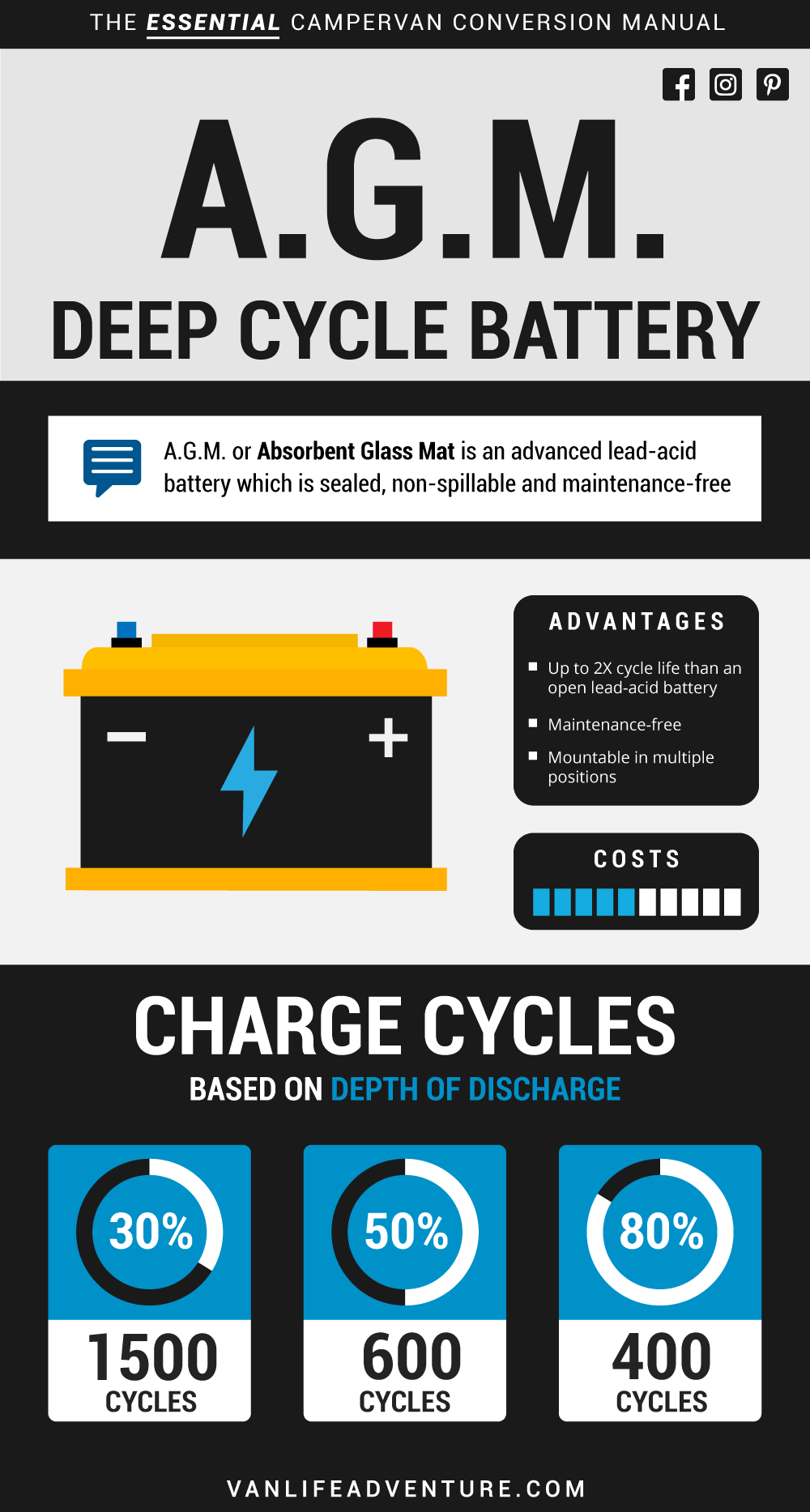
[su_divider top=”no” divider_color=”#e2e2e2″ size=”1″ margin=”30″]
[su_row][su_column size=”1/2″ center=”no” class=””]
REASONS TO BUY
[su_list icon=”icon: check-circle” icon_color=”#000000″ class=”page-list”]
- Cheapest V.R.L.A battery
- Up to two times longer cycle life than a standard flooded battery
- Maintenance-free
- Non-spillable
- Mountable in multiple positions
- Excellent performance under high loads
- Brilliant performance in challenging climates
- Fast charge speed
- Vibration resistant
[/su_list]
[/su_column]
[su_column size=”1/2″ center=”no” class=””]
REASONS TO AVOID
[su_list icon=”icon: times-circle” icon_color=”#000000″]
- A.G.M. batteries cost more compared to a V.L.A. battery of the same capacity.
- Heavy
[/su_list]
[/su_column][/su_row]
[su_divider top=”no” divider_color=”#e2e2e2″ size=”1″ margin=”30″]
What is an A.G.M. battery?
The abbreviation A.G.M. stands for absorbent glass mat and is a sealed lead-acid battery that was initially developed for the military in the 1980s. There high performance and enhanced electrical reliability are ideally suited for a campervans auxiliary electrical system.
An A.G.M. battery still contains lead and an electrolyte like an open lead-acid battery, but what makes these batteries different is the internal construction.
Inside, you will find both positive and negative plates separated by an absorbent glass mat. These mats effectively trap the electrolyte and stop it from flowing.
[su_spacer size=”20″]
How many charge cycles does an A.G.M. battery have compared to the depth of discharge?
The number of charge cycles an A.G.M battery will produce is dependant the depth of discharge, ambient temperature, manufacturer and battery manufacturer/model.
Furthermore, these figures will vary widely based on:
- The environment of the battery
- How the battery is used
- How the battery is charged
- The age of the unit
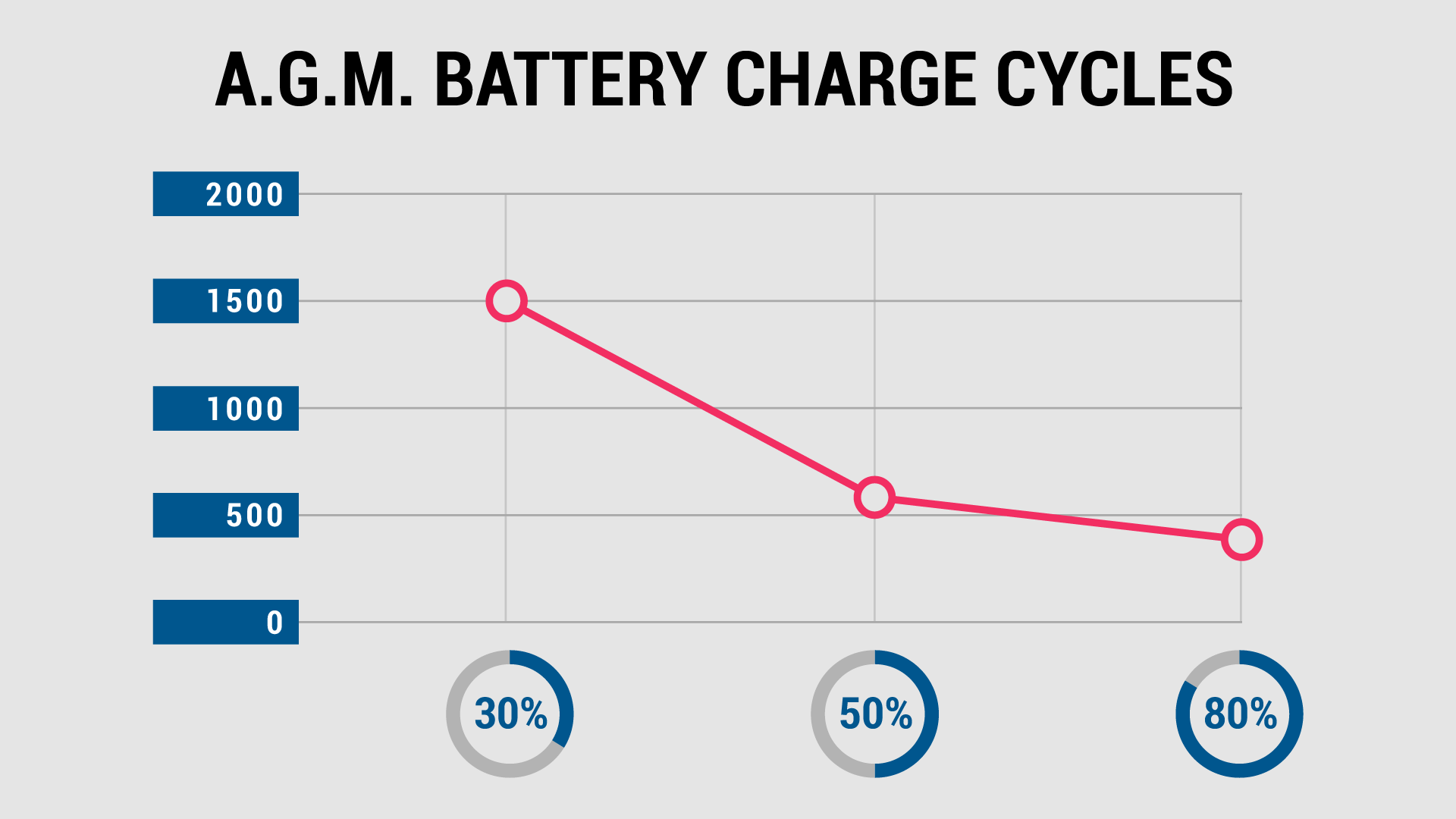
[su_note note_color=”#bedced” text_color=”#000000″ radius=”0″]
Cycles Vs. D.O.D
- 400 cycles @ 80% depth of discharge
- 600 cycles @ 50% depth of discharge
- 1500 cycles @ 30% depth of discharge
Source: These figures listed are taken directly from the datasheet of a scientific study published by VictonEnergy.
[/su_note]
[su_spacer size=”20″]
Do I have to vent an A.G.M. battery?
An A.G.M. battery will still release a minimal amount of gas if the internal pressure exceeds a certain level.
Although the amount of discharge is considerably less than a conventional open lead-acid battery, it is still advisable to install an A.G.M. battery in an area with ventilation.
[su_spacer size=”20″]
Do I have to maintain an A.G.M. battery?
As an A.G.M. battery is sealed, this all but eliminate the need for any mechanical maintenance.
However, it is still advised to carry out function testing and regular cleaning.
[su_spacer size=”20″]
How do I mount an A.G.M. battery?
Majority of A.G.M batteries can be mounted upright and on their sides with no problems, but should not be mounted upside down.
Gel Battery
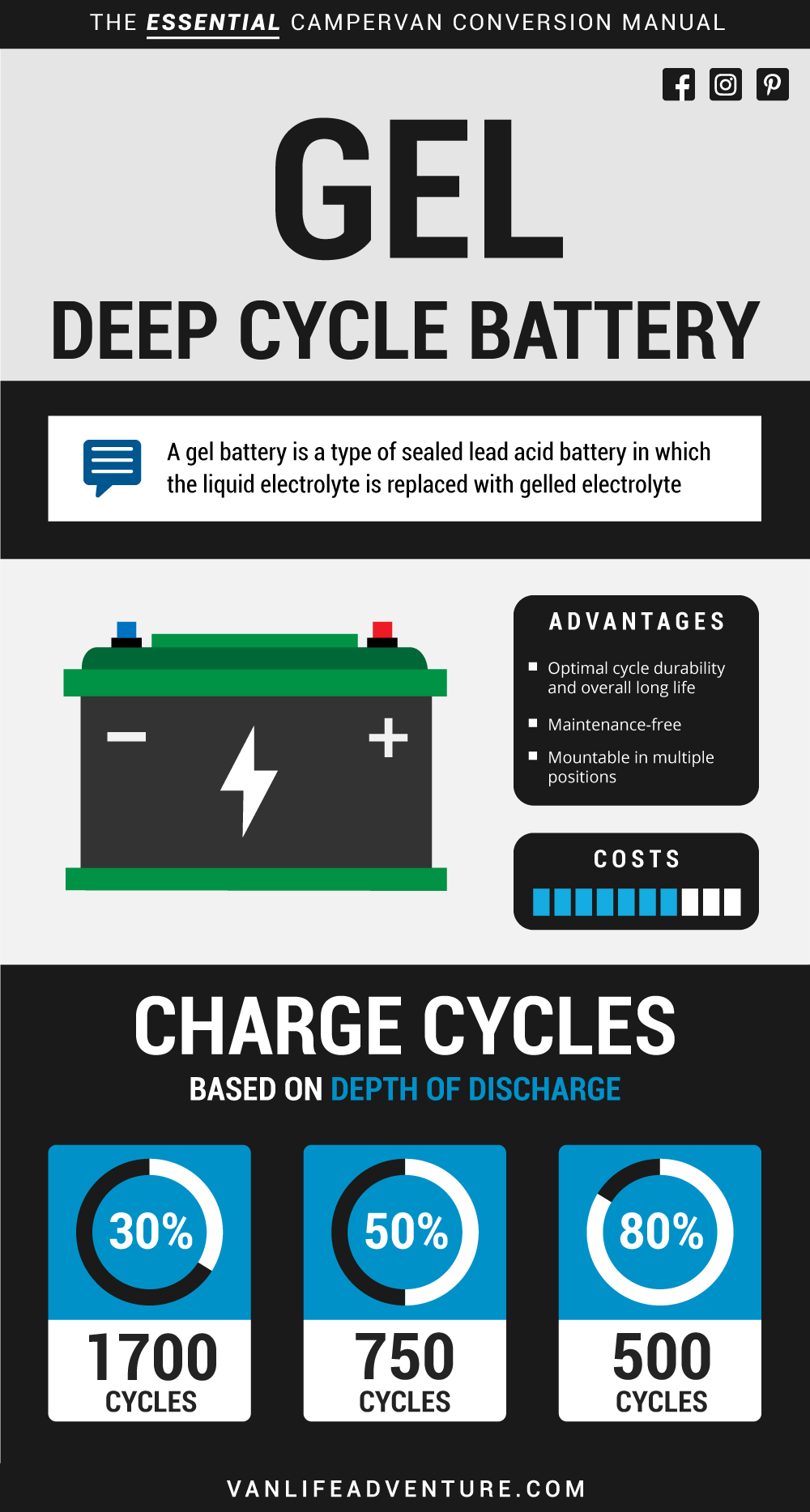
[su_divider top=”no” divider_color=”#e2e2e2″ size=”1″ margin=”30″]
[su_row][su_column size=”1/2″ center=”no” class=””]
REASONS TO BUY
[su_list icon=”icon: check-circle” icon_color=”#000000″ class=”page-list”]
- Excellent slow discharge rates
- Operates better higher ambient operating temperatures
- Long cycle life
- Maintenance-free
- Non-spillable
- Mountable in multiple positions
- Excellent performance under high loads
- Excellent performance in challenging climates
- Fast charge speed
- Vibration resistant
[/su_list]
[/su_column]
[su_column size=”1/2″ center=”no” class=””]
REASONS TO AVOID
[su_list icon=”icon: times-circle” icon_color=”#000000″]
- Most expensive V.R.L.A. battery
- Heavy
[/su_list]
[/su_column][/su_row]
[su_divider top=”no” divider_color=”#e2e2e2″ size=”1″ margin=”30″]
What is a gel battery?
Very similar to an A.G.M. battery, a gel battery is a type of sealed lead-acid battery in which the liquid electrolyte contains a silica additive. As a result, the electrolyte is now a gel.[5]
[su_spacer size=”20″]
Home many charge cycles does a gel battery have compared to the depth of discharge?
The number of charge cycles a gel battery will produce is directly dependant on the depth of discharge and battery manufacture/model.
Furthermore, these figures will vary widely based on:
- The environment of the battery
- How the battery is used
- How the battery is charged
- The age of the unit
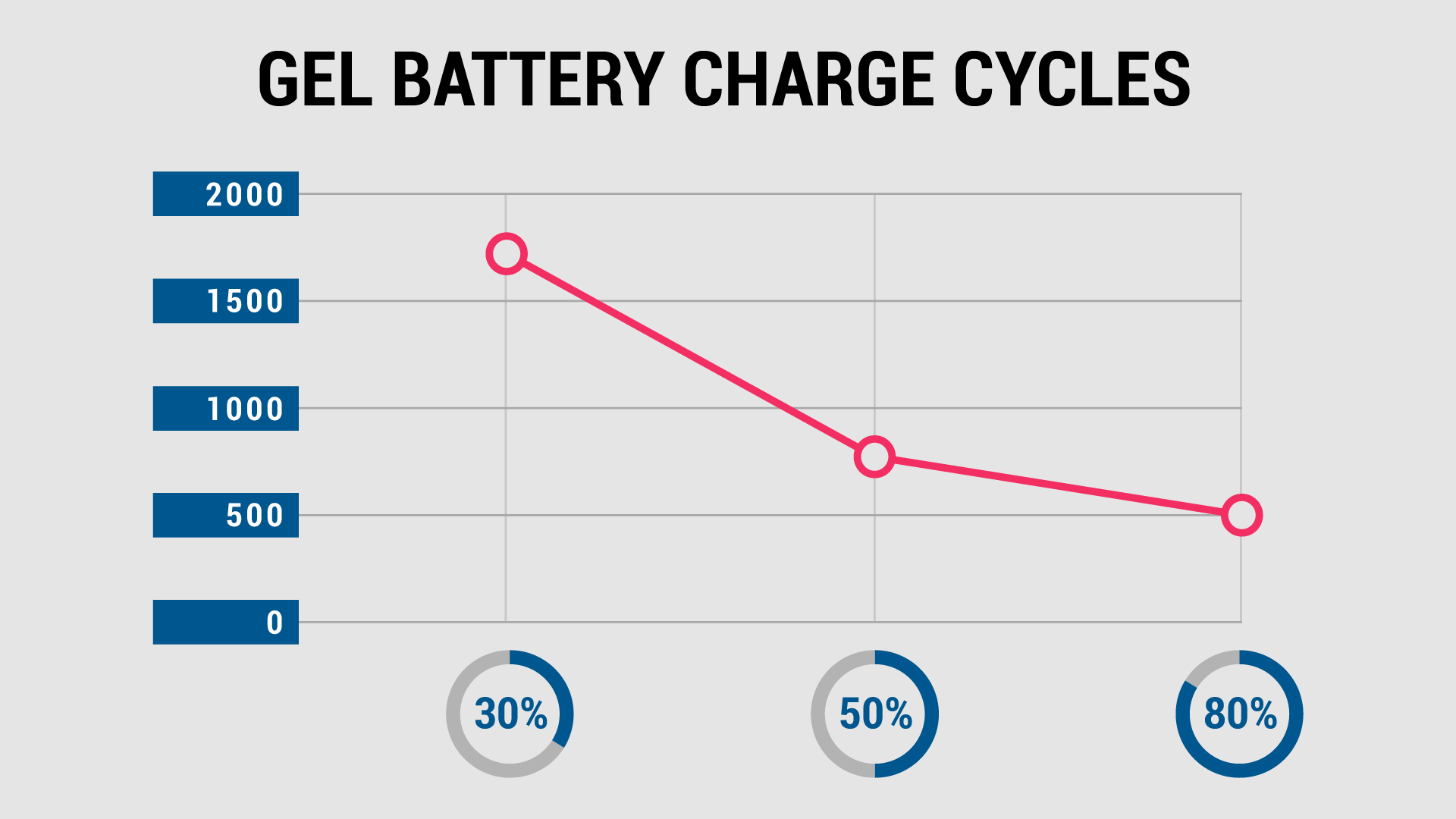
[su_note note_color=”#bedced” text_color=”#000000″ radius=”0″]
Cycles Vs. D.O.D
- 500 cycles @ 80% depth of discharge
- 750 cycles @ 50% depth of discharge
- 1800 cycles @ 30% depth of discharge
Source: These figures are taken directly from the datasheet of a scientific study published by VictonEnergy.
[/su_note]
[su_spacer size=”20″]
Do I have to vent a gel battery?
A gel battery will still release a minimal amount of gas if the internal pressure exceeds a certain level.
Although the amount of gas discharge is considerably less a conventional open lead-acid battery, it is still advisable to install a gel battery in an area with ventilation.
[su_spacer size=”20″]
Do I have to maintain a gel battery?
As a gel battery is sealed, this all but eliminate the need for any mechanical maintenance.
However, it is still advised to carry out function testing and regular cleaning.
[su_spacer size=”20″]
How do I mount a gel battery?
Gel batteries can be mounted upright and on their sides with no problems, but should not be mounted upside down.
[su_divider top=”no” divider_color=”#e2e2e2″ size=”1″ margin=”60″]
BATTERY TECHNOLOGY 3: Lithium Batteries
What is a lithium battery?
The first commercially viable lithium battery was developed in 1985 by Nobel prize winner Akira Yoshino[6]. Since then, the technology has undergone tremendous advancements. These batteries are now found in everything; from cars to smartphones, kitchen appliances to spacecraft, the list is endless.
It was only a matter of time before they became a viable option for the leisure market. A lithium-ion battery is around half the weight of a lead-acid battery, yet have over twice the energy density. This means you can get away with a smaller battery size that will also reduce your vehicles overall weight.
One thing to note is, just like a lead-acid battery, you can damage a lithium-ion battery if you fully discharge it. Thankfully, most batteries have an inbuilt electronic controller that shuts down the output when the charge level approaches a predetermined point.
[su_spacer size=”20″]
What are the main types of lithium batteries used in a campervan?
Although there are many different types of lithium batteries out there, the primary type you will find is a LiFePO4 battery.
LiFePO4 Battery
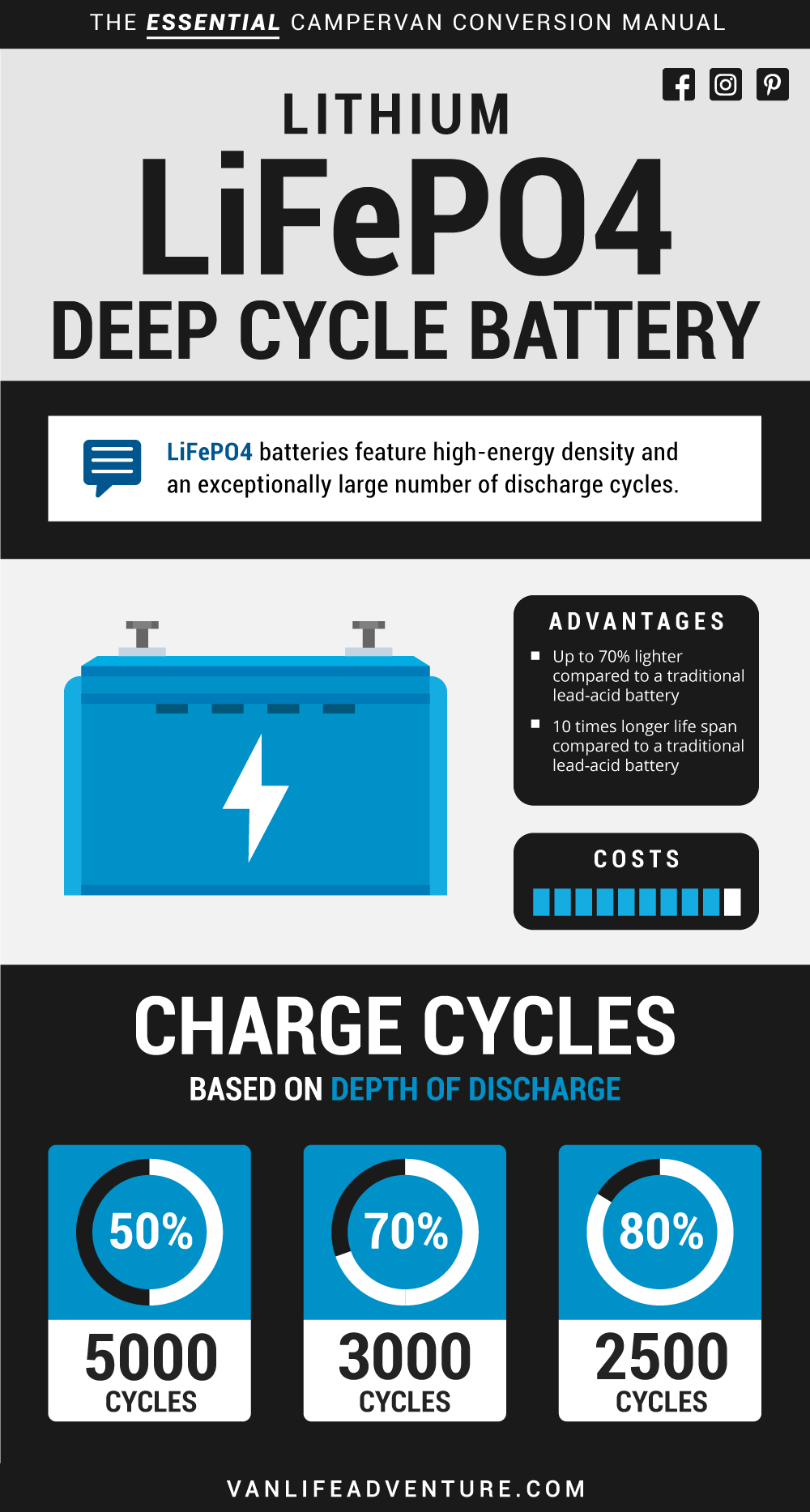
[su_row][su_column size=”1/2″ center=”no” class=””]
REASONS TO BUY
[su_list icon=”icon: check-circle” icon_color=”#000000″ class=”page-list”]
- Up to 70% lighter than that of a conventional lead-acid battery
- Life span 10 times longer than that of a traditional lead-acid battery
[/su_list]
[/su_column]
[su_column size=”1/2″ center=”no” class=””]
REASONS TO AVOID
[su_list icon=”icon: times-circle” icon_color=”#000000″]
- Extremely high costs (although, over a batteries lifetime, a LiFePO4 battery can work out to be the cheapest option)
- You cannot charge a LiFePO4 battery below freezing.
[/su_list]
[/su_column][/su_row]
What is a LiFePO4 battery?
The abbreviation LiFePO4 stands for lithium iron phosphate and is a relatively new type of lithium solution.
A LiFePO4 battery uses lithium-ion-derived chemistry and shares many advantages and disadvantages with other lithium-ion batteries.
What is the recommended depth-of-discharge for a LiFePO4 battery?
A LiFePO4 battery has a recommended depth-of-discharge to 80%. However, some lithium-ion battery manufactures claim their batteries can go to a 95% D.O.D.
How many charge cycles does a LiFePO4 battery have compared to the depth of discharge?
The number of charge cycles a LiFePO4 battery will produce is directly dependant on the depth of discharge and battery manufacture/model.
Furthermore, these figures will vary widely based on:
- The environment of the battery
- How the battery is used
- How the battery is charged
- The age of the unit
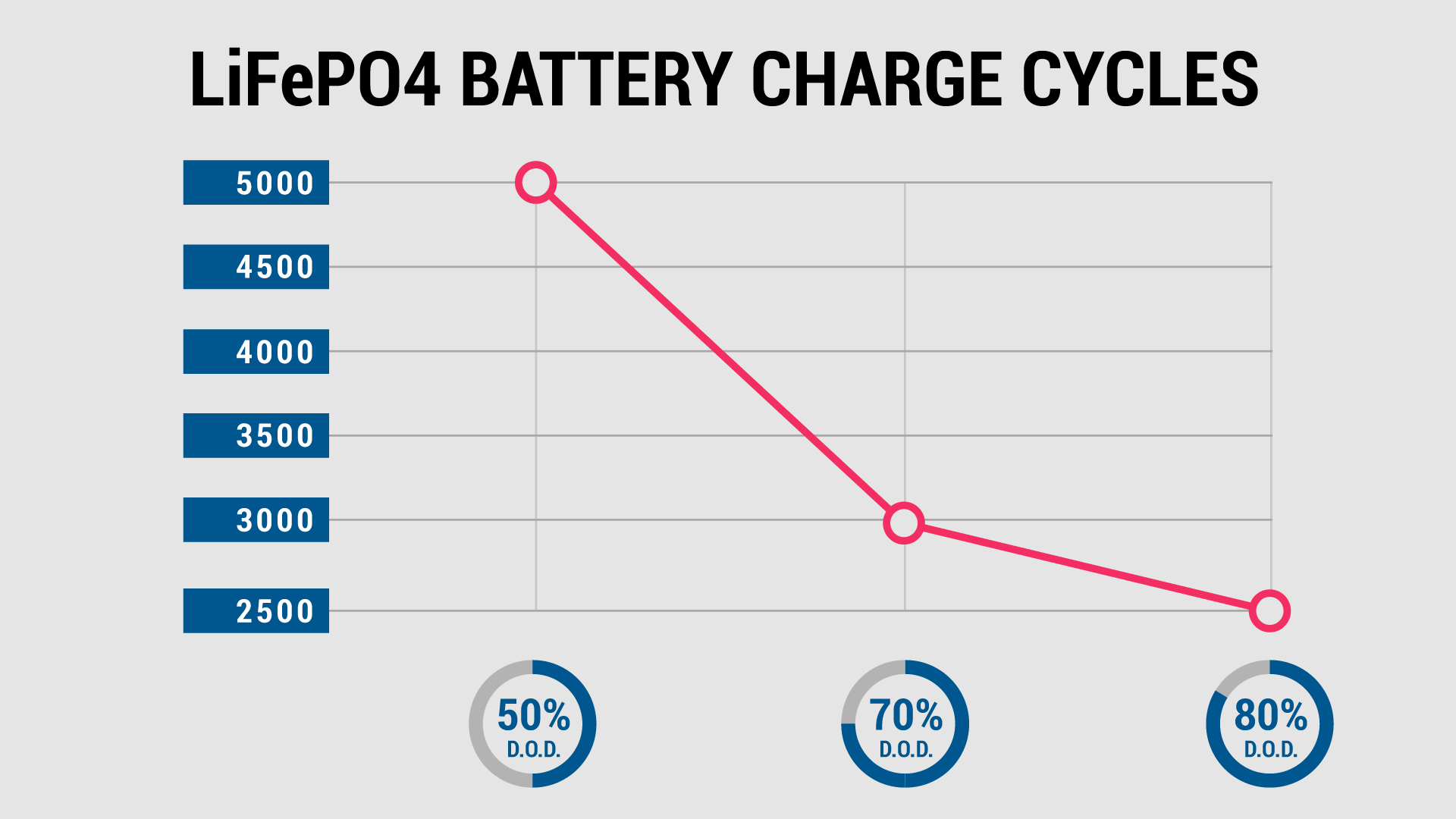
[su_note note_color=”#bedced” text_color=”#000000″ radius=”0″]
Cycles Vs. D.O.D
- 2500 cycles @ 80% depth of discharge
- 3000 cycles @ 70% depth of discharge
- 5000 cycles @ 50% depth of discharge
Source: The figures here are taken directly from a scientific datasheet published by VictonEnergy.
[/su_note]
Do I have to maintain a LiFePO4 battery?
As a LiFePO4 battery is sealed, there is no battery maintenance require.
However, a LiFePO4 battery still requires function testing and regular cleaning for optimal operation.
How do I mount a LiFePO4 battery?
Since a LiFePO4 battery contains no liquid, they can be mounted in any direction, including upside down.
[su_spacer size=”60″]
[su_note note_color=”#FAFAFA” text_color=”#000000″ radius=”0″ class=”note-style2″]
Related Reading
[td_block_7 category_id=”135″ sort=”random_posts” limit=”3″ tdc_css=””]
[/su_note]
Battery Capacity
Understanding Battery Ratings & Labels
The power and longevity of a battery are noted by its amp-hour (Ah).
In simple terms, this denotes how long a battery will last if it is not re-charged.
For example, if a battery has a rating of 100 Ah, it will be able to provide 10 amps for 10 hours, or 1 amp for 100 hours.
[su_divider top=”no” divider_color=”#e2e2e2″ size=”1″ margin=”60″]
Leisure Battery Terminology
What is a charge cycle?
A charge cycle is a process of discharging then re-charging a battery.
[su_spacer size=”20″]
What is D.O.D. (depth of discharge)?
The D.O.D., otherwise known as depth of discharge, is a percentage of power you would use from a batteries available capacity.
For example, an A.G.M. battery at 100% charge may have a reading of 13.00 volts of electricity. At 0% charge (flat), the battery would have a reading of 10.50 volts. If you were to use 50% of the available power, the battery would have a reading of 12.05 volts. This would then be known as a 50% depth of discharge.
You would now re-charge the battery back to 100% (13.00 volts).
This whole process is known as a deep-cycle.
[su_spacer size=”20″]
What is cycle life?
Cycle life is the total number of charge then discharge cycles a battery can sustain before it needs to be replaced.
Leisure Battery Frequently Asked Questions
[su_accordion]
[su_spoiler title=”How do you get the most from your leisure battery?” open=”no” style=”fancy” icon=”plus-square-1″]
Non-Battery-Type Specific
- Use a thin layer of Vaseline or petroleum jelly to the battery’s terminals to prevent oxidisation.
- Check clamps regularly for rust on the contact surfaces.
- Never leave the battery uncharged.
- Always use high-quality clamps.
- When your park your campervan up for a while, remember to maintain your battery. A trickle charger is a good investment for this situation.
V.L.A.
- Ensure adequate ventilation to allow gases to escape while the battery is charging.
- If fitted, ensure that the gas relief tube remains correctly installed.
- Check that the electrolyte level covers the lead plates on the battery. If not, top up with deionised water.
[/su_spoiler]
[su_spoiler title=”Which Factors Can Affect The Performance Of The Battery?” open=”no” style=”fancy” icon=”plus-square-1″]
There are several factors which may affect the performance of a leisure battery.
- Temperature: Temperature plays a significant role in battery performance. Lower temperatures diminish the capacity.
- Age: The typical lifespan of a battery is around 5 years. As cells get older, performance inevitable reduces.
- Charge Cycles: Deep cycle batteries, like mobile phone batteries, are limited by the number of discharge-recharge cycles they can tolerate. Clearly, the more you use the battery, and the more power you consume, the more times the battery will be re-charged.
- Rating: The more appliances you power, and the size of those appliances, the bigger your leisure battery will need to be. For example, motors or heater will require significant energy and therefore, a larger battery.
While all of these will influence the performance of the battery, it is essential to remember that there are many complex factors at play.
[/su_spoiler]
[su_spoiler title=”Can you charge a leisure battery from the mains?” open=”no” style=”fancy” icon=”plus-square-1″]
A leisure battery can be charged from mains power. This would involve installing a shore power hook-up system aboard your campervan.
[/su_spoiler]
[su_spoiler title=”Can you charge a leisure battery with a solar panel?” open=”no” style=”fancy” icon=”plus-square-1″]
A leisure battery can be charged from solar power. This would involve installing a solar power system aboard your campervan.
[/su_spoiler]
[su_spoiler title=”Can you charge a leisure battery with a standard battery charger?” open=”no” style=”fancy” icon=”plus-square-1″]
A leisure battery can be charged from a standard battery charger. This would involve installing a shore power hook-up system aboard your campervan.
[/su_spoiler]
[su_spoiler title=”Why does my leisure battery sometimes smell of rotten eggs?” open=”no” style=”fancy” icon=”plus-square-1″]
Sometimes during charging, a battery may produce a rotten egg smell. This is a chemical reaction of the battery materials and is usually a sign that the battery is overcharging.
Should you detect such a scent, carefully check if the battery feels hot. If so, the battery is overcharging, and will ultimately cause irreparable damage.
Furthermore, this means sulphurous gases are being produced, and there could be a high risk of explosion.
[/su_spoiler]
[/su_accordion]
[su_divider top=”no” divider_color=”#e2e2e2″ size=”1″ margin=”60″]
[su_spoiler title=”Sources” open=”yes” style=”fancy” icon=”plus-square-1″]
[1] “What Is the Difference between a Normal Lead-Acid Car Battery and a Deep Cycle Battery?” HowStuffWorks. HowStuffWorks, April 1, 2000. https://auto.howstuffworks.com/question219.htm.
[2] “A Simple History of Batteries – Panasonic,” Panasonic North America, accessed July 31, 2020, https://www.panasonic.com/global/consumer/battery/academy/history.html
[3] “Can the Lead-Acid Battery Compete in Modern Times?” Lead-acid Rechargeable Battery Information – Battery University. Accessed July 31, 2020. https://batteryuniversity.com/learn/archive/can_the_lead_acid_battery_compete_in_modern_times.
[4] “VRLA Battery.” Wikipedia. Wikimedia Foundation, July 24, 2020. https://en.wikipedia.org/wiki/VRLA_battery.
[5] https://www.batterystuff.com/kb/articles/5-battery-types-explained-sealed-agm-gel.html
[6] Nobel Prize in Chemistry 2019: Lithium-ion batteries. ScienceDaily, October 9, 2019. https://www.sciencedaily.com/releases/2019/10/191009082508.htm.
[/su_spoiler]
Did you find this guide useful?
Thank you for reading our highly detailed guide! We hope it was informative and helpful. If you enjoyed the content and found it useful, we would greatly appreciate it if you could leave a quick review to let us know your thoughts. Your feedback helps us improve and continue creating valuable content for our readers. Alternatively, if you feel inclined, you could also support us with a small donation. As a small independent website, every contribution helps us continue our work and keep creating quality content. Thank you for your support!
The whole process takes less than 60 seconds and directly supports VanLife Adventure.
Disclaimer
VanLife Adventure has made every effort to make sure all information displayed on this website is correct and valid. However, neither VanLife Adventure nor its employees warrants or accepts any liability for the use of any of the information presented here. The user is cautioned to seek competent engineering assistance when carrying out any installations.
- Share
- Like
- Tweet
- Pin
- Digg
- Del
- Tumblr
- VKontakte
- Buffer
- Love This
- Odnoklassniki
- Meneame
- Blogger
- Amazon
- Yahoo Mail
- Gmail
- AOL
- Newsvine
- HackerNews
- Evernote
- MySpace
- Mail.ru
- Viadeo
- Line
- Comments
- Yummly
- SMS
- Viber
- Telegram
- Subscribe
- Skype
- Facebook Messenger
- Kakao
- LiveJournal
- Yammer
- Edgar
- Fintel
- Mix
- Instapaper
- Copy Link



